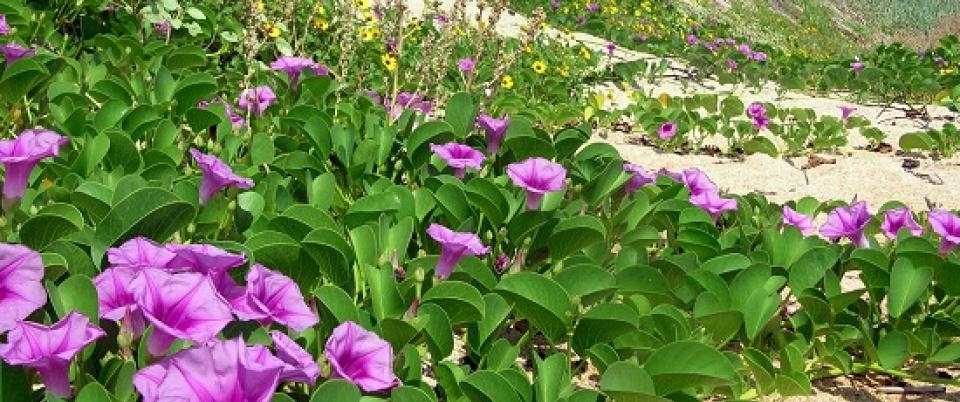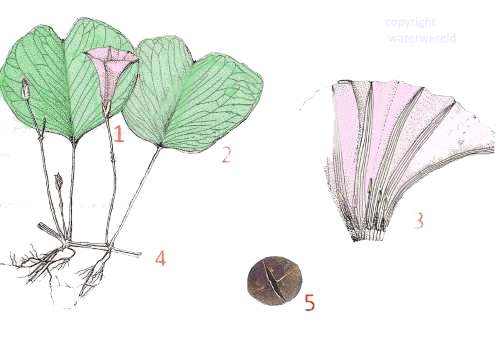Beach morning glory or Goats foot
The Beach morning glory is a very fast growing trailing vine . It can be found on tropical dunes and beaches. Beach Morning Glory has shiny pink flowers. The seeds are disperged by water , fresh or the see. Its has an enourmous spread around the tropical world, it can be found on almost every tropical beach. The Goats foot is important as colonizer of the sandy beaches: The plants covers large areas and forms a rather continuous and thick mat that helps to keep the sand from moving : the roots holds prevents the sand from moving and the leaves protect the sand from strong wind.

Adapted to a live on the beach
Beach Morning Glory isn’t capable to use salt water directly, but its deep, fleshy tap-roots form an extensive and deep running system caple of providing fresh water and are a holdfast against the forces of the wind. The evaporation is limited by the thick leaves (xerofyt) . The funnel-shaped flowers, tend to open early in the morning and close in the heat of the day. The leaves are also resistant againt salt spray. The fast growing rope-like stems are up to 5 meter long. Beach Morning Glory has only few predators that are capable to eat from the poisionous leaves: they contain the alkaloid ergotamine, a strong poison , especially for insects.

A succesful beach plant
The plant is a colonizer, but has already colonized almost all the tropical beaches: it is the most important tropical beach plant. There a some good reasons for its succes story: Beach Morning Glory produces large amount of seeds, these seeds floats and are resistent against (salt) seewater. But the vegetative way of propagation is even more important: after an hurricane or tsunami the thick mat of the Beach Morning Glory is broken down completely. But these fast growing parts will float and are often capable to recolonize a new beach . A new frontier are railroads tracks : This is another hostile environment because of rocky railbedding , the mechanical removal and herbicidal spray.
Goats foot beneficial uses
The most important is the ability to prevent sand for moving. It forms humus , the start of other beach live. Those plants get a chanche because Beach Morning Glory also prevent the sands from burying those plants.
Beach morning glory reduces pain
There is attention for the farmacological compounts of the Beach Morning Glory. It was already known by ancient cultures , like the Aztecs, for its pain relieving properties, and is becoming more popular for the treatment of dolorous processes.(4) Probably because of inhibitory effects on prostaglandin synthesis. (5)
Beach morning glory in the garden
In desert lands the Beach morning glory can be seen as a garden plant, the flowers. The creeping stems, up to 5 ,meter long can be used to cover an ugly wall or fence.
Oceanic dispersal
Beach Morning Glory produces abundant amount of small seeds that are capable to float on the ocean, these seeds are called sea beans or drifting seeds. They are resistent against salt water, and can travel large distances transported by ocean streams. This is the way Beach Morning Glory reaches the beaches on remote tropical islands. The seeds are light and can also be transported locally by stormwind, and this way reach railway tracks. The vegatative propagation is more important for smaller distances: parts of large vines are brought by sea or stormwinds to other beaches.
Sea beans or drifting seed
Sea beans of Goats foot can stay for a long period floating in the ocean current and travel this way a large distance, reaching isoltad beaches. Shoreline species produce seeds that float for very long periods of time so that they are eventually entrapped by shoreline vegetation or deposited at the waterline. They then also need a long time to recover and start germination. Developing Goats foot obtain fresh water and mineral nutrients from a lens (soil layer) of fresh water (derived from inland rainfall) which literally floats above the denser salt water beneath the beach sand.
Sea beans on sea
It is estimated that tropical seeds found on European shores probably have been adrift for a year or longer. Sea-beans like Goats foot float because they have an internal air pocket within the seed. But their weight grows as some sea creatures (like barnacles and goose barnacles) and algae grow on their surface, in the end the trip stops by sinking because of increasing weight. Plant species that rely on ocean dispersal are rare, there are 250.000 plant species but only 250 produce drifting seeds that can survive an ocean trip.and only about half of these are known to produce seeds that can float in seawater for more than a month and still be viable.

Convolvulaceae
Other members of the Ipomoae family :
Reference
1 subsp. brasiliensis
Flore de Madagascar et des Comores, Convolvulacées, vol. 171: Convolvulacées, p. 229 (2001) [S.0.]
2 Blanco, M., Flora de Filipinas (1877)
3 Isolation and identification of compounds with antinociceptive action from Ipomoea pes-caprae R Krogh, Die Pharmazie
4 Isolation and identification of compounds with antinociceptive action from Ipomoea pes-caprae Krogh R. Die Pharmazie 1999
5 Compounds Inhibiting Prostaglandin Synthesis Isolated from Ipomoea pes-caprae.
